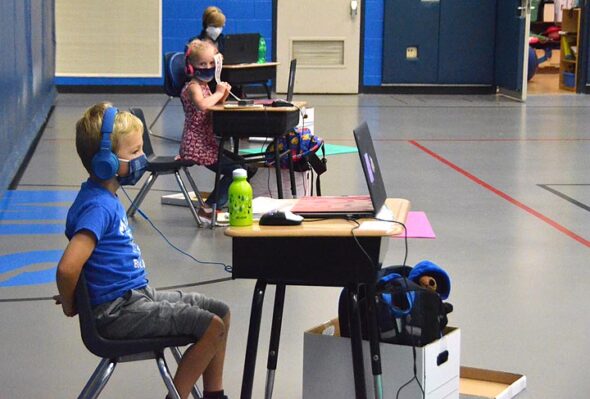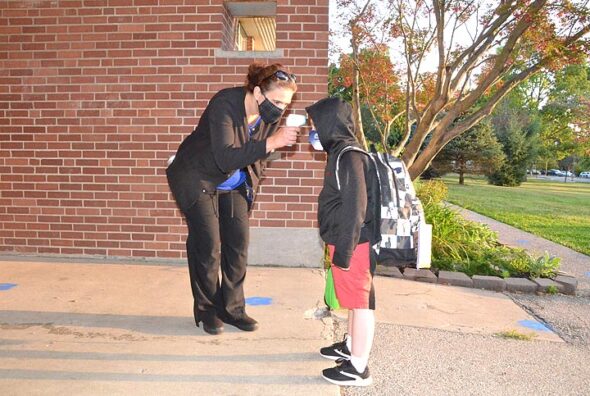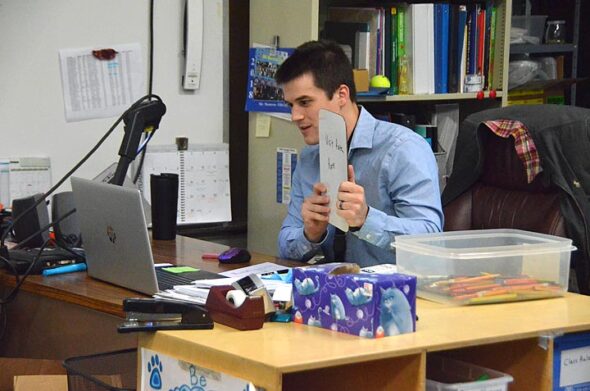
The district’s Safe Centers for Online Learning Program allows a limited number of students, who don’t have an adult available to monitor their online studies at home, to have supervised studies in the school buildings. Mills Lawn staff members oversee six “pods” of learners in groups distributed across the school building. Students Henrick Cain, Anastasia Mayer and Henry Campbell, pictured here, are part of a K–3 pod located in the school gym. Each student keeps their personal belongings and materials with them at their desks. (Photo by Carol Simmons)
A look inside Yellow Springs schools
- Published: September 30, 2020
How’s it going?
That’s the question the News has been putting to Yellow Springs Schools administrators, teachers, staff, students and parents the past couple of weeks. School has been in session for about a month, with instruction taking place online since the opening of the 2020–21 academic year on Aug. 27.
Although the district went virtual last spring along with the rest of Ohio’s schools closed in response to the COVID-19 pandemic, the online curriculum this fall is a different animal altogether, district officials say. Last spring was more of a crisis situation, an emergency stop-gap to close out the school year, while the new academic year offers instruction more comparable to in-person classes, according to Superintendent Terri Holden. Instituted for the first six-week quarter, which ends Oct. 31, remote learning could continue for an undetermined time depending on COVID case numbers in the area and the results of staff and family surveys expected to go out later this week, Holden said Monday.
Last week, this reporter spent a day in the schools, observing and talking to teachers, principals and staff about conducting school online — this article is based on that experience. An article drawing from student and family perspectives will appear in next week’s News.
So, how is it going inside the schools?
For this observer, who has spent years within those walls — as a former district parent and in-class volunteer, an education graduate student and now a reporter covering schools — the halls and classrooms felt thoroughly familiar, with teachers, staff and a limited number of on-site students going about the business of school.

An unidentified student had his temperature taken by school nurse Charlyn Cantrell before entering Mills Lawn School on Friday morning, Sept. 18. The district requires everyone going into the schools to have a temperature check before entering. (Photo by Carol Simmons)
At the same time, however, the differences were stark. Face masks were ubiquitous. Plastic partitions have been installed in offices, dividing staff and visitors. Most classrooms were empty of students; and in many, the tables, desks and chairs were stacked or pushed into a corner. At Mills Lawn, about 30 staff members and 48 students are in the building each day, while the middle/high school campus has about 33 staff and 17 students present daily.
More subtle signs are blue paw prints — representing the district’s Bulldog mascot — painted six feet apart on hallway floors, to encourage physical distancing; hand sanitizer placed throughout the buildings; and the cleaning of restrooms every two hours. And no one enters the buildings without a temperature check.
Teachers, alone in their rooms, have set up distinct areas where they prepare and conduct their online classes. With their desks placed in front of white boards, maps and instructional posters, they address students through laptop computers, which often rest on top of a spare box or a stack of books to give the screen and built-in camera more height. Some teachers have even brought in floor lamps and other additional lighting to better illuminate their presentations.
McKinney Middle School and Yellow Springs High School performance teacher Lorrie Sparrow-Knapp has set up multiple areas in her room, which resembles the black-painted backstage of a theater.
“How can I make the space interesting to students?” she said was a question she asked herself at the start of the year. Her answer was to “create sets.”
There’s a “conversation corner,” featuring a large padded chair, table and lamp. There’s a theater tech space, with props, costumes and a large work table; and a music corner, with a piano and musical scores. And in the center of the room is a table holding a large video screen and laptop, where Sparrow-Knapp creates lessons and engages with student work, often in the form of videos or digital music tracks.
“I make a lot of videos,” Sparrow-Knapp said. “I try to make it dynamic for them.”
She said that much of her instruction is conducted with individual students, and that a variety of technology tools allow students to record their work and share it with her and other students.
She said she wants students to find joy in their classes. Group assignments have included the designation of a music appreciation day, when students are not only instructed to listen to a piece of music, but also “get up, dance, move and enjoy life,” Sparrow-Knapp said.
The importance of students being able to pull back from the computer screen and take breaks throughout the day was a theme stressed by teachers and administrators alike. Families have expressed concern about the amount of time their children now spend online, and school board member Steve McQueen brought this concern forward at the most recent regular school board meeting, Thursday, Sept. 9. He asked if there were more ways to get children safely outside while the weather is still accommodating to outdoor activities.
Superintendent Holden responded by saying that families with such concerns should contact the building principals.
“Nobody wants children on screens all day,” she said.
The school day
On its face, the school day schedule appears to allow for breaks and flexibility of online time.
A typical Mills Lawn day begins at 8 a.m. with a 20-minute “morning meeting” for each class, followed by a 10-minute break. Next up is language arts, which is slotted for 65 minutes but may also include individual reading and writing. After another 10-minute break comes 65 minutes for math, with a portion given to personal work, followed by another 10-minute break. “Specials” — music, gym, art — and lunch divide the hours between 11 a.m. and 1 p.m.; and the rest of the afternoon, until dismissal at 2:30 p.m., is designated for small group work to complete teacher assignments and projects.
Mills Lawn Principal Michelle Person said that every class follows that same basic schedule, which she feels gives cohesion to the day.
School aide Nan Meekin, who oversees an eight-student pod of kindergarten, first and second graders as part of the Safe Centers for Online Learning program, for students who don’t have an adult available to monitor their online work from home, said that the students are encouraged to take breaks, stand up and move. On the floor in front of each of the students’ desks, spaced widely around two adjacent classrooms normally separated by a folding wall, is an individual yoga mat for stretching, sitting or lying.
In addition, “I try to get them outside as much as possible,” Meekin said. As she spoke, a kindergartener on the other side of the room stood up and started stretching as part of his class’s morning meeting, while another kindergartener was invited by his teacher, Linnea Denman, to participate in motions to accompany a song about phonics.
“Any questions?” Ms. Denman asked the group.
“I have to use the potty,” a small voice spoke from the video conference call.
“You may do that,” her teacher responded.

Sixth grade teacher Ryan Montross last week gave a math lesson in ratios with his students through an online video conferencing application. Students wrote answers to his queries on small white boards like the one he held here; and they shared their results at the same time. (Photo by Carol Simmons)
Second-grade teacher Heidi Hoover said she encourages her students to take “20-20-20” breaks, where every 20 minutes, they take 20 seconds to look away from their screens and refocus on something 20 feet away, preferably out through a window.
At the middle and high school, the school day goes from 8:30 a.m. to 3:30 p.m. The district had already been planning, before COVID was part of the equation, to move from a block-class schedule to a seven-period schedule this school year. Administrators decided to stick with that plan, Principal Jack Hatert said, sitting down to talk at a picnic table in front of the building.
While designated breaks, other than lunch, are not listed on the master schedule, Hatert said the district has tried to build in an element of flexibility for students in the time they spend online or completing their work. Teachers also have some flexibility in how they structure class periods, he said.
Although a number of regular classes were halted last spring when schools closed, all classes are being offered in an online format this year, Hatert said. Students follow their personal class schedules, but daily classes alternate between synchronous — real-time class instruction — and asynchronous — pre-taped or written lessons that can be completed when a student chooses, as long as the work is submitted by the teacher’s deadlines. Each day alternates synchronous and asynchronous approaches between the individual periods, and each class alternates from day to day.
The asynchronous periods also give teachers time to plan and create instructional content.
Challenges
Teachers at both schools agreed that online instruction takes more preparation and is more labor intensive than in-person classes.
“I’m exhausted at the end of the day,” third-grade teacher Megan Bennett said. “I don’t stop working or planning all day.”
There’s also the challenge of “learning new technology tools,” Bennett said.
Principal Hatert said the same is true for teachers at the middle and high school.
“Our teachers are working harder than they’ve ever worked,” he said.
Bennett said that being online doesn’t allow for the same level of spontaneity, or ability to respond to “teachable” moments as in-person instruction. The moments are more structured and prepared online.
Second-grade teacher Hoover agreed.
“It’s harder to have a true conversation,” she said. “And that’s often where learning takes place.”
Hannah Weinstein, who teaches 10th grade and Advanced Placement U.S. history, government and economics at the high school, and Amy Minehart, the art teacher at Mills Lawn, both said that getting to know and connecting with students who are new to them has also been a challenge in the virtual setting.
Minehart said that she’s had to revise her lessons to accommodate supplies students have on hand in their homes, and to keep activities from “getting messy,” as is possible in her well-stocked classroom.
On the plus side, Weinstein said she doesn’t have to redirect student attention as much as when they’re all together in person.
Being aware of student needs
Hatert said that teachers and staff try to keep student welfare in mind, while also pressing to provide a rigorous educational experience.
He said that before the new year began, he anticipated that students would receive 100% of the classroom content normally presented, but he’s modified that view, coming to feel that half or two-thirds is more realistic.
A day-long exercise run by middle and high school staff during the week before classes began involved going through a typical day from a student’s perspective.
“I was wiped out by mid-day,” Hatert said. He said the experience was eye-opening and led staff to reconsider expectations.
“Now, we’re pushing quality over quantity.”
Although he recognizes the strain remote learning can put on students, Hatert said some students are thriving, especially those who are more detail oriented, or those “who sometimes get caught up in social drama.” And the most outgoing teens are still finding ways to socialize, Hatert believes.
He said he most worries about “kids who are less social, who don’t necessarily reach out to others and now don’t have direct access.”
Weinstein said she’s implemented several activities to address students’ emotional well-being. An avowed animal lover, she welcomes students’ pets as “part of the classroom.”
“I think for a lot of the students, it helps them stay calm.”
She’s also initiated “Positive Affirmation Monday,” when everyone has to say nice things about each other. Some students were reluctant at first, she said, but she believes such efforts go a long way toward “creating a positive classroom culture.”
Weinstein says she is starting to see results, too, with her classes working together better.
Coming back
Teachers and principals all said they think the current online schedules will transition easily to in-person classes, whenever district leaders decide to reopen the schools to all students.
Performance teacher Sparrow-Knapp, however, cautions against making that decision too quickly. As much as she misses being physically present with her students, Sparrow-Knapp said she hopes the schools continue with online instruction for the rest of the school year.
“It’s not safe to come back,” she said. “I feel very strongly about that.”
She noted that one of her grandfathers died at the age of 22 during the influenza pandemic of 1918.
“We have to think long term,” she said.
Superintendent Holden said she would like to have a recommendation to take to the school board at its next regularly scheduled meeting Thursday, Oct. 8.
“The sooner we have a return plan, the better for parents,” she said.
All teachers agreed that they miss being with their students.
Mills Lawn art teacher Minehart, who tries to minimize at-home mess-making, said she looks forward to the day when students can “get in here and make some more messes.”
The Yellow Springs News encourages respectful discussion of this article.
You must login to post a comment.
Don't have a login? Register for a free YSNews.com account.















No comments yet for this article.